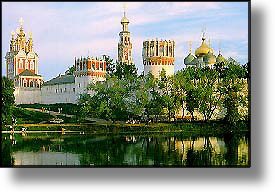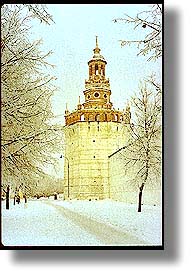 Old
Moscow
Old
Moscow | Exploring Moscow | |
| Moscow's Kremlin | |
| Moscow's Red Square | |
| Fine Arts & Museums | |
| Theatres of Moscow | |
| Old Moscow | |
| Mementos of the Soviet | |
| Moscow Accommodations |
Original Official Site of the Russian National Tourist Office
 For
centuries the palaces and churches of the Kremlin were the only buildings
made of stone. The rest of the city was constructed of wood and was
destroyed with each great fire (of which ancient Moscow had plenty).
As a result, surviving artifacts of old Moscow are rare. They consist
of major structures around the city and just a few wooden buildings
hearty enough to survive the conflagrations.
For
centuries the palaces and churches of the Kremlin were the only buildings
made of stone. The rest of the city was constructed of wood and was
destroyed with each great fire (of which ancient Moscow had plenty).
As a result, surviving artifacts of old Moscow are rare. They consist
of major structures around the city and just a few wooden buildings
hearty enough to survive the conflagrations.
Novodevichiy Convent & Cemetery
 At
the same time that Moscow's Kremlin was reinforced as a protective
citadel for the city center, a series of fortified monasteries were
constructed as an outlying defensive chain to the south. The most
famous of these is the beautiful Novodevichy Convent, founded in
1524 and situated along a prominent bend in the Moskva River. The
convent's fame, however, has less to do with its role as a protective
fortress than with its aristocratic and political history, for Novodevichy
was the favored destination for high-ranking women banished from
court. The most famous such inmate was Peter the Great's elder sister
Sofia, who had ruled as Regent during his minority. After Peter came
of age and--with some difficulty--claimed his throne, it was to Novodevichy
that he banished his Machiavellian sibling in 1689. Nine years later,
as Peter was returning to Russia after his travels in Europe, Sofia
engineered an attempted coup from the convent. The coup failed, and
Peter reached home in time to participate in the mass execution of
the rebels. Although Sofia was not to be harmed, she was apparently
driven mad when the bodies of her supporters were strung up outside
her window.
At
the same time that Moscow's Kremlin was reinforced as a protective
citadel for the city center, a series of fortified monasteries were
constructed as an outlying defensive chain to the south. The most
famous of these is the beautiful Novodevichy Convent, founded in
1524 and situated along a prominent bend in the Moskva River. The
convent's fame, however, has less to do with its role as a protective
fortress than with its aristocratic and political history, for Novodevichy
was the favored destination for high-ranking women banished from
court. The most famous such inmate was Peter the Great's elder sister
Sofia, who had ruled as Regent during his minority. After Peter came
of age and--with some difficulty--claimed his throne, it was to Novodevichy
that he banished his Machiavellian sibling in 1689. Nine years later,
as Peter was returning to Russia after his travels in Europe, Sofia
engineered an attempted coup from the convent. The coup failed, and
Peter reached home in time to participate in the mass execution of
the rebels. Although Sofia was not to be harmed, she was apparently
driven mad when the bodies of her supporters were strung up outside
her window.
Novodevichy is also famous for the cemetery that lies beyond its
south wall. Here lie many famous writers, artists, and politicians
including Gogol, Checkov, Bulgakov, Mayakovsky, Stanislavsky, Shostokovich,
Eisenstein, and Nikita Khrushchev, the only Soviet leader not buried
behind Lenin's Mausoleum.
English House
The English House provides an interesting little glimpse of the life of an imprisoned Brit in Ivan the Terrible's court. In the middle of the sixteenth century, Ivan gave the house to English representatives of the Muscovy Company, a private trading consotium similar to the East India Company. The envoys hoped to win for England a share in the increasingly lucrative fur trade. Ivan's diplomatic interests, however, centered on the possibility of marrying Elizabeth I, the "Virgin Queen." When the Tsar learned that Elizabeth wasn't exactly jumping at this idea, he became (surprise) rather upset. In order to express his frustrations, Ivan confined the queen's ambassador to English House for four months. Although the house is currently undergoing restoration, even those sections that are still open give visitors a sense of the life of a foreigner in Moscow four hundred years ago.
Palace of the Romanov Boyars
This reconstructed palace was the home of the Romanovs before they became Russia's ruling family. The palace was built in the sixteenth century by Nikita Romanov, Ivan's brother in law and Michael Romanov's grandfather. When Michael was named as Tsar in 1613, at the end of the Time of Troubles, the entire family moved into the Kremlin. The Romanov palace was restored in the nineteenth century, from which time it has served as a public museum. The rewards of a visit today go beyond a glimpse at the ancestral home of the last Tsars--the palace is also a lovely and intriguing example of early aristocratic life in Moscow.







